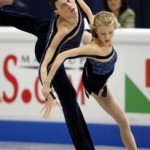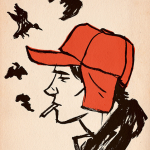High-brow Cultural Vegetable of the Week: The Ambassadors (Hans Holbein, 1533)
Vegetable Equivalent: Any vegetable grown in and exported from France
Nutritional Value: A reminder of how we use art to stave off death
Recommended Serving Size: Five good minutes actually looking at the thing
In 1533, King Henry VIII of England married his second wife Anne Boelyn, creating an international furor. He had gotten Archbishop Thomas Cranmer to annul his first marriage against the Pope’s wishes, and Clement VII let his opinion on the matter be known by promptly excommunicating Henry and Anne. One year later, Henry would appoint himself head of the English state and church, and the Anglican Church was born.
In the midst of this political and religious chaos, Henry welcomed two French visitors to his court: Jean de Dinteville (a diplomat) and Georges de Selve (a bishop). Henry’s court painter, Hans Holbein the Younger, recorded the visit with a painting of tempera oils on oak. The double portrait, known as “The Ambassadors,” offers us the humanist ideal: two learned men, representing state and church, surrounded by the instruments and markers of Renaissance learning. The only hint of trouble is a blurred anamorphic stain that cuts across the intricately tiled mosaic beneath Dinteville and Selve’s feet.
That stain only makes sense when juxtaposed with the rest of the painting’s opulent and meticulously ordered images. Dinteville (on the left in rich fur) and Selve (in clerical black) balance the painting with their postures and expressions of cool detachment. They are Catholics visiting the court of a king who has made an international stink, yet, surrounded by books and globes, they have successfully cleared their faces of concern. The painting visually displays human learning at its highest: music (the lute and open Lutheran psalter on the cabinet), astronomy (the celestial globe), and geometry (a quadrant and torquetum). In their vocations, the men represent university training in rhetoric, grammar, and logic.
The portrait shows Holbein’s incredible mastery of perspective, a subject with which Renaissance thinkers were obsessed. Every item surrounding Dinteville and Selve hints at man’s attempt to exert dominion, to subject the entire world to man’s point of view. But Holbein’s greatest perspectival accomplishment is placing a perfectly-rendered anamorphic skull in the middle of this lush portrait. The skull can only be seen properly when the rest of the picture is effectively distorted. Holbein manages to convey death’s haunting presence in a setting where man most displays his control over the natural world.
Of course, Holbein’s skull is itself artistically rendered so that when death is all we can see, our view is no less distorted. Holbein’s painting asks us to juggle perspectives, to neither indulge ourselves in a futile attempt for complete knowledge — our own mortality makes that impossible — nor give way to a fatal pessimism. The portrait has three ambassadors: Dinteville, Selve, and Death. Its lesson is that, as humans, we will never be able to fully account for all three at the same time.











